Input interpretation

triethanolamine
Chemical names and formulas

formula | (HOCH_2CH_2)_3N Hill formula | C_6H_15NO_3 name | triethanolamine IUPAC name | 2-(bis(2-hydroxyethyl)amino)ethanol alternate names | 2, 2', 2''-nitrilotriethanol | 2-(bis(2-hydroxyethyl)amino)ethanol | daltogen | sting-kill | tris(2-hydroxyethyl)amine | trolamine mass fractions | C (carbon) 48.3% | H (hydrogen) 10.1% | N (nitrogen) 9.39% | O (oxygen) 32.2%
Lewis structure
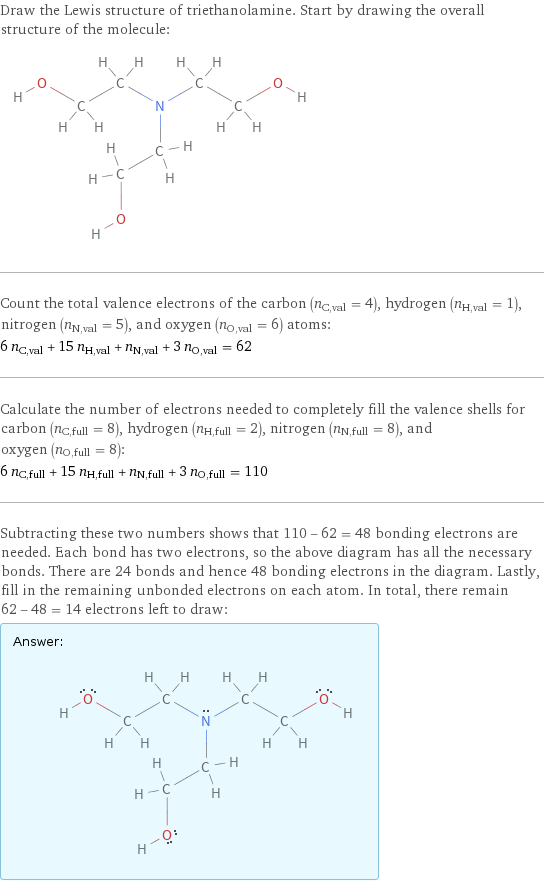
Draw the Lewis structure of triethanolamine. Start by drawing the overall structure of the molecule: Count the total valence electrons of the carbon (n_C, val = 4), hydrogen (n_H, val = 1), nitrogen (n_N, val = 5), and oxygen (n_O, val = 6) atoms: 6 n_C, val + 15 n_H, val + n_N, val + 3 n_O, val = 62 Calculate the number of electrons needed to completely fill the valence shells for carbon (n_C, full = 8), hydrogen (n_H, full = 2), nitrogen (n_N, full = 8), and oxygen (n_O, full = 8): 6 n_C, full + 15 n_H, full + n_N, full + 3 n_O, full = 110 Subtracting these two numbers shows that 110 - 62 = 48 bonding electrons are needed. Each bond has two electrons, so the above diagram has all the necessary bonds. There are 24 bonds and hence 48 bonding electrons in the diagram. Lastly, fill in the remaining unbonded electrons on each atom. In total, there remain 62 - 48 = 14 electrons left to draw: Answer: | |
3D structure
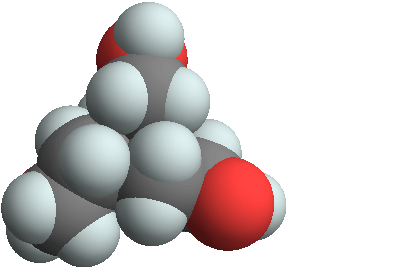
3D structure
Basic properties
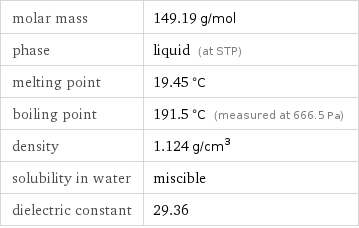
molar mass | 149.19 g/mol phase | liquid (at STP) melting point | 19.45 °C boiling point | 191.5 °C (measured at 666.5 Pa) density | 1.124 g/cm^3 solubility in water | miscible dielectric constant | 29.36
Liquid properties (at STP)
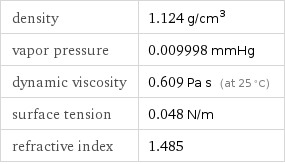
density | 1.124 g/cm^3 vapor pressure | 0.009998 mmHg dynamic viscosity | 0.609 Pa s (at 25 °C) surface tension | 0.048 N/m refractive index | 1.485
Units

Thermodynamic properties
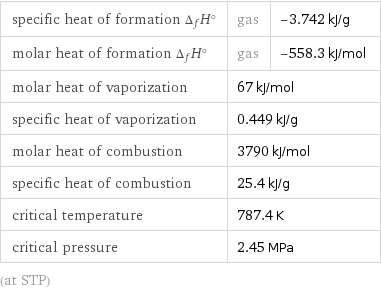
specific heat of formation Δ_fH° | gas | -3.742 kJ/g molar heat of formation Δ_fH° | gas | -558.3 kJ/mol molar heat of vaporization | 67 kJ/mol | specific heat of vaporization | 0.449 kJ/g | molar heat of combustion | 3790 kJ/mol | specific heat of combustion | 25.4 kJ/g | critical temperature | 787.4 K | critical pressure | 2.45 MPa | (at STP)
Chemical identifiers
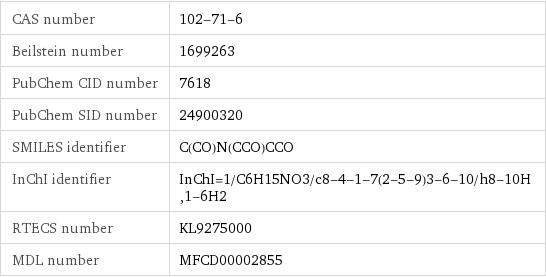
CAS number | 102-71-6 Beilstein number | 1699263 PubChem CID number | 7618 PubChem SID number | 24900320 SMILES identifier | C(CO)N(CCO)CCO InChI identifier | InChI=1/C6H15NO3/c8-4-1-7(2-5-9)3-6-10/h8-10H, 1-6H2 RTECS number | KL9275000 MDL number | MFCD00002855
NFPA label

NFPA label
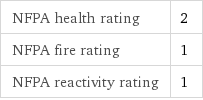
NFPA health rating | 2 NFPA fire rating | 1 NFPA reactivity rating | 1